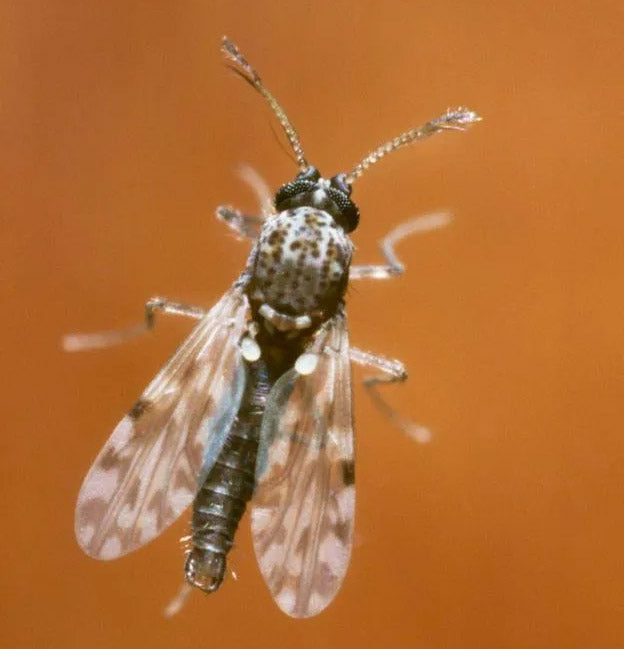Regardless of which of their many aliases you recognize them by, no-see-ums (AKA: sand flies, biting midges, etc.) can be a source of major irritation – both on your mood and your skin. Due to their miniature size, no-see-ums have earned their reputation as being especially difficult to see, let alone to catch. But it’s more than just their penchant for drawing blood that has people talking… Do no-see-ums carry diseases like mosquitoes do? And if so, what are the symptoms of no-see-ums bites, and should you and your family be concerned this summer?

Can No-See-Um Bites Make You Sick?
The answer to this question, at least in part, is based on where you live, and depends on which insect is being referenced. Generally speaking, no-see-ums in the US do not carry pathogens or diseases that are harmful to humans, unlike the deadly transmission rates of mosquitoes.
The insects commonly and mistakenly referred to as sand flies in the United States are a species of biting midge called Culicoides furens, a related insect from a distinct genus from the disease vector sand flies in other parts of the world. These sand flies, or Lutzomyia verrucarum, are found in parts of South America (particularly in the tropical regions of Colombia, Ecuador and Peru) that are known to host species of biting flies capable of transmitting a variant of Bartonella bacilliformis that can manifest itself as Carrion’s disease in humans. Left untreated, this infectious disease can cause hemolytic fever – a condition that interferes with the body’s blot-clotting abilities – with fatality rates over 90 percent.
Some species of Culicoides in the US do carry parasites and are known vectors of diseases in ruminant livestock, but the threat to humans in the US is low, with no-see-ums primarily causing a nuisance and allergic reactions.
To reiterate, for those of us who live farther north, no-see-ums, or the insects incorrectly referred to as sand flies, generally do not pose a risk to humans, though their bites are irritating and painful.

Do No-See-Ums Bite?
About this question, there is no ambiguity: no-see-ums definitely bite. Just as with their irksome counterparts, mosquitoes, it is actually only the female no-see-ums that shoulder the responsibility for the tiny, but curiously painful and itchy little bites that you may find yourself receiving. The reason for this is that female no-see-ums need the protein found in blood to help provide the adequate nutrition for pregnancy and larval reproduction.

What Attracts No-See-Ums?
No-see-ums are attracted to light sources. However, they are also able to detect heat, the carbon dioxide exhaled by vertebrates, as well as increased concentrations of lactic acid, typically found in taller people and those with higher BMIs.
What Are the Best No-See-Um Repellents?
With a variety of products out there designed specifically for no-see-ums, it can be confusing to understand what is truly the best method for preventing no-see-um bites. However, an entomologist at the University of Florida states that “applications of insecticides targeting the adult stage are not efficient. While this type of application may kill biting midges active on a given night, they are continually dispersing from the larval habitat and entering areas of human activity. It would require insecticide applications on a daily basis in some areas, and this is not efficient or environmentally sound.” In other words…an insecticide application around your home may be effective some of the time, but it is not likely to quell the problem entirely. At Best Bee Brothers, we prefer to use chemical-free solutions that are in harmony with nature anyway. Skip the chemicals and protect your skin with our essential-oil-based Natural No-See-Um Repellent spray to prevent bites. Note: Protecting your dogs from no-see-ums is different from protecting a human from them, as dogs are very sensitive to essential oils. Remember to always reach out to your veterinarian when you are looking for solutions for your pets.

If no-see-ums are a problem in your area, you can also try some passive intervention to keep them away. As a general rule of thumb, no-see-ums are very weak fliers. This means that something as innocent as a living room or outdoor fan (set on high) could be enough to keep them at bay. Additionally, the University of Florida entomologist suggests that “homeowners can install proper screening for windows and patios to prevent no-see-ums from entering residences and outdoor areas used for leisure and entertaining. Most biting midges can pass through a 16-mesh insect wire screen and netting, so a smaller mesh size is required.”
How to Get Rid of No-See-Um Bites
Despite their small size, female no-see-ums have mandibles that are designed to effortlessly penetrate skin. Translation: big chompers mean big hurt! Though it’s probably not a fair comparison to a wasp or bee sting, a bite from a no-see-um is certainly not pleasant. Moreover, no-see-ums bites are often considerably itchier than mosquito bites and can last for quite a bit longer as well. The truth is that getting rid of no-see-um bites is simply a matter of time. However, there are some remedies you can apply to help take the sting off the bite or reduce some of the inflammation that causes the itching. Visit our No-See-Ums Bites: Natural Treatment Methods for our favorite natural remedies.
- Meritxell Garcia-Quintanilla, Alexander A. Dichter, Humberto Guerra, and Volkhard A. J. Kempf, “Carrion’s Disease: More Than a Neglected Disease,” Parasites & Vectors 12, no. 141 (March 2019): https://doi.org/10.1186/s13071-019-3390-2.
- Garcia-Quintanilla et al., “Carrion’s Disease.”
- C. Roxanne Connelly, “Biting Midges (Culicoides spp.),” Featured Creatures, University of Florida Department of Entomology and Nematology, May 2005, https://entnemdept.ufl.edu/creatures/aquatic/biting_midges.htm
- J. E. Cilek and D. L. Kline, “Adult Biting Midge Response to Trap Type, Carbon Dioxide, and an Octenol-Phenol Mixture in Northwestern Florida,” Journal of the American Mosquito Control Association 18, no. 3 (September 2002) :228–31, https://pubmed.ncbi.nlm.nih.gov/12322947/.
- Ian Sample, “Midges Favour Tall Men and Overweight Women, Study Finds,” Guardian, July 28, 2010, https://www.theguardian.com/environment/2010/jul/28/midges-tall-men-overweight-women.
- Connelly, “Biting Midges.”
- Connelly, “Biting Midges.”









Leave a comment
All comments are moderated before being published.
This site is protected by hCaptcha and the hCaptcha Privacy Policy and Terms of Service apply.